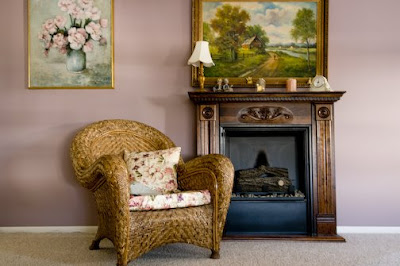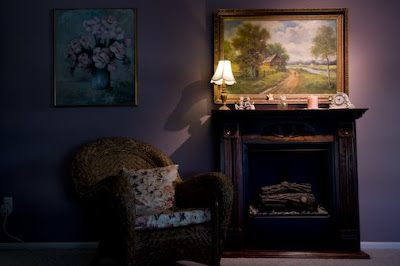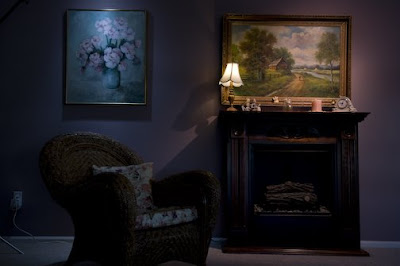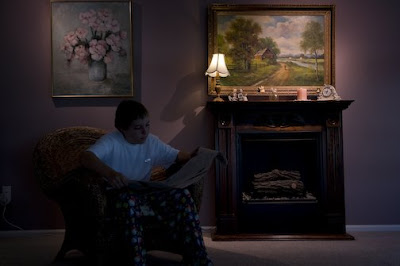
One of the hardest thing for me when I was new to lighting, was seeing the possibilities in a location. When I first started in photography, I was lucky to have worked with a very talented photographer in Houston, TX. Those who followed this blog my remember me mentioning his name in the past, Joe Baraban.
When I went to work for Joe, I had never been in a studio before, seen or used strobes let alone realize that you could actually make a living taking pictures. It would just blow my mind to watch Joe walk into a drab location and absolutely transform it using light. Joe could see the possibilities in his minds eye and creating a dramatic scene which was not immediately visible me. Developing this kind of skill takes time, practice and hard work.
When I arrive on location, go through a process of location assessment. What type of lighting is existing, tungsten/daylight/other. Do I have control over those light sources, can I use any one of those or all of those lights to my advantage? I mentally close my eyes to the existing light and imagine the scene lit differently using my light (the one's I have with me at the time) and what other light that may exist. The amount of equipment you have on hand surly determines how far you can transform a location with light.
When I arrive in a location or space that is larger than I can possibly light with the gear on hand, I still think BIG however I might light SMALL. I'm going to let the existing ambient light do the heavy lifting for me, I'm going to use what ever ambient light that available as my fill. I can than use my lights to accent the details.
I shot the above photo this morning. I was walking through our master bedroom and thought this would be a good exercise in lighting. I'll show you the process of building this shot with the series of photos below.
Here is how the original scene looked before starting. Bedroom entrance is to the left of the frame. We have three windows pouring in light to the room. Two of those are at camera right on either side of the bed and the other directly behind me and to my right. In this shot the camera WB was set to daylight
 In the photo below, I've added one SB-800 strobe on a boom zoomed to the 105 setting on the head in order to light the painting on the right. I have also fitted the head with a foam flag to prevent the light from falling forward toward the floor and lens of the camera.
In the photo below, I've added one SB-800 strobe on a boom zoomed to the 105 setting on the head in order to light the painting on the right. I have also fitted the head with a foam flag to prevent the light from falling forward toward the floor and lens of the camera.

Here is how the original scene looked before starting. Bedroom entrance is to the left of the frame. We have three windows pouring in light to the room. Two of those are at camera right on either side of the bed and the other directly behind me and to my right. In this shot the camera WB was set to daylight
 In the photo below, I've added one SB-800 strobe on a boom zoomed to the 105 setting on the head in order to light the painting on the right. I have also fitted the head with a foam flag to prevent the light from falling forward toward the floor and lens of the camera.
In the photo below, I've added one SB-800 strobe on a boom zoomed to the 105 setting on the head in order to light the painting on the right. I have also fitted the head with a foam flag to prevent the light from falling forward toward the floor and lens of the camera.
In this next photo, you can see that I have added another SB-800 on a boom to light the painting on the left side of the frame. This was my first exposure with this added light and I realized that I did not put a full CTO (Color Temperature Orange) filter on the strobe. Remember that the WB on the camera is set to tungsten and any daylight (strobes) will have a cooler color temp. in the photo.
 I corrected the color of the strobe by adding a full CTO to it and repositioned it to a more pleasant position on painting on the left. The results of those changes are shown below.
I corrected the color of the strobe by adding a full CTO to it and repositioned it to a more pleasant position on painting on the left. The results of those changes are shown below. I than asked my son who was busy downstairs fighting an intense battle of Halo to sit in for a test shot. I wanted to see what the scale of the shot would look like and how I might light a person seated in the chair.
I than asked my son who was busy downstairs fighting an intense battle of Halo to sit in for a test shot. I wanted to see what the scale of the shot would look like and how I might light a person seated in the chair. I than grab another SB-800, put a grid on it and feathered the light just past and in front of his face. The grid I use is one which was designed for a Novatron Snoot. With a little gaffers tape and velco, the grid works well. I might also add that I put a full CTO filter on this strobe as well. The results of adding this 3rd light is shown here.
I than grab another SB-800, put a grid on it and feathered the light just past and in front of his face. The grid I use is one which was designed for a Novatron Snoot. With a little gaffers tape and velco, the grid works well. I might also add that I put a full CTO filter on this strobe as well. The results of adding this 3rd light is shown here. You throw a few Sterno cans in the fake fireplace and you have a real cozy environment. In short order, Chris was bored and and quickly fell asleep. I wonder if it had anything to do to the fact that I gave him the Wall Street Journal to read?
You throw a few Sterno cans in the fake fireplace and you have a real cozy environment. In short order, Chris was bored and and quickly fell asleep. I wonder if it had anything to do to the fact that I gave him the Wall Street Journal to read?The rest of the photos show the complete set up of lights and one showing a panel at the window at the far right. I did so because this was a new window and we have not put blinds up yet, that's on my "honey do" list.
I hope you have enjoyed this post, look around your own home and pick a spot and practice with your lights!


16 comments:
David - this is such a good tutorial for those of us who are not too visual.
It really encourages me to be positive when I look at a scene.
Great article. It really gives me more confidence the next time I want to light an otherwise "blah" looking area.
It also helped someone like myself who doesn't have that great of an imagination!
Absolutely wonderful stuff David, just like your videos on YouTube.
One question though — What type of light stands do you use on these shots?
Very nice walk through. I really enjoyed seeing shots of beginning to end. Thanks!
Excellent challenge - I find myself not willing to take risks a lot of times because I'm still in my "light visualization" infancy...doing some around the house stuff will be great motivation for me when I'm on assignment and trying to incorporate strobes.
Thanks, David!
Great post, David.
Seeing how you worked through the process to get to your result is very informative. Thank you.
That was amazing! I really enjoy reading your posts, they have always something new for me. Thanks!
Could you elaborate a little about your booms. Traditional booms, designed for studio strobes are overkill for small strobes. It would great to just attach one stand to another with a small device. Cheaper, less to carry. Whatcha using?
Thinking about how to light an area is something I struggle with right now. It is very nice having people like you and Hobby and Mcnally around and showing us how to work thru an environment.
Thanks
this is just perfect. I could read posts like this all day and the effort you put into show the change with each addition of a light was really helpful.
Great example thanks!
What sort of boom arm do you use ?
I've been asked several time about the boom arms I use. I use several, I own 2 portable bogen booms and I also use a Photoflex reflector arm as a boom.
The Photoflex arm does not extend as far as the Bogen booms, however, if I am traveling "lite" I can get by with them. When traveling, I take along 2 Photoflex counter weights. These weights are plastic bags that you can fill with water and can be hung on the back of the boom arm.
Hi David
I appreciate posts which give examples not just of procedures but of thought processes and it's astonishing how we need to be brought back to the simple fact that all photos depend on the quantity and quality of light. When I switched my own approach from a static website to a blog at http://johnrochaphoto.net/ I wondered how it would go but I think it's clear that interactive posts like yours must make the whole thing more interesting for all of us.
All the best
John Rocha
Damn that's nice work!
I'm just starting out with flash lighting and demonstrations such as this are a superb learning tool. Thank you so much. Dale Hardin
Hi Dale: Best of luck with your flash education. If you have an opportunity to attend a workshop with me that would be super. DT
Post a Comment